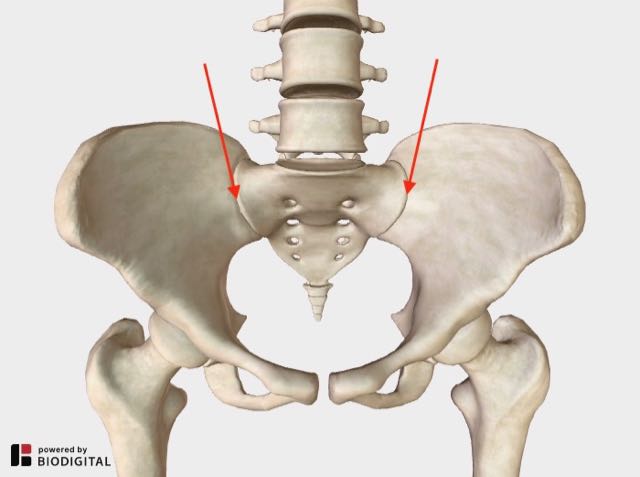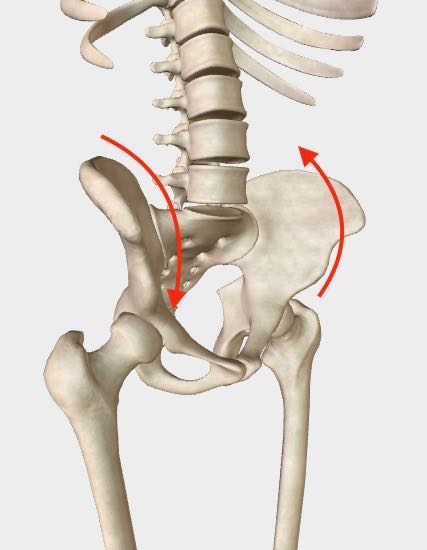Understanding Sacroiliac Joint Dysfunction
 Front view of sacroiliac joints.
Front view of sacroiliac joints.Sacroiliac Joint Dysfunction occurs in one or both of the sacroiliac joints where the flat, triangular shaped sacrum bone at the base of the spine interconnects with the pelvis.
The symptoms of sacroiliac pain can be similar to those of sciatica – pain in the buttocks and down the leg – but sacroiliac joint dysfunction is a different problem from sciatica.
We have two sacroiliac joints, one on each side of the sacrum. The most common problems I see in my practice are hypo-mobility and hyper-mobility.
Hypo-mobility means that the joint is stuck, fixed, unmoving.
Hyper-mobility means that the joint is too loose and unstable.
Most common cause of si Joint dysfunction

The most common cause of SI joint dysfunction is pelvic torsion.
This will often result in one SI joint becoming stuck and immobile, while the other becomes unstable and too mobile.
The pain that can arise in a stuck and tight SI joint usually has a deep aching quality that responds positively to vigorous movement and the body getting warmed up.
On the other hand, the pain that can arise in an SI joint that's too mobile and unstable tends to feel sharp and pointed -- my clients have described it as, "like a knife stabbing the area" -- and does NOT respond positively to vigorous movement. In fact, such movement can aggravate an overly mobile SI joint.
A fairly reliable way to self-evaluate whether you pain is primarily rooted in a stuck SI joint or an overly mobile SI joint is to ask if one of the above descriptions fits.
Either way, when SI joint problems are rooted in pelvic torsion, the restoration of pelvic balance is the only way to resolve the pain and problems long term.
 Postural Blueprint for correcting pelvic Torsion
learn more
|
When Your Sacroiliac Joint is Stuck or Hypo-mobile
When the SI joint is stuck it will likely have a restricted, tight feeling. You feel you want to stretch it out all the time, and may twist your body into various contortions in an attempt to gain relief.
In such cases, the fascia, the muscles, and even the deep ligaments around the joint may have adapted to a shortened state.
Various influences can cause tissues to shorten including a sedentary lifestyle and trauma (such as a fall where there’s impact to the tailbone). I also see a high incidence of tightness in the sacroiliac ligament and the surrounding tissues in women post-partum.
Near the end of pregnancy, hormonal changes cause the sacroiliac joints to relax in preparation for delivery. But a rebound effect can occur in which the tissues around the sacrum tighten up again to the point of creating restriction.
The result can be the hypo-mobile version of Sacroiliac Joint Dysfunction.
Relieving Sacroiliac Joint Dysfunction in a Stuck or Hypomobile Joint
A stuck sacroiliac joint can be an uncomfortable thing. Relieving it, however, can be relatively easy; no more difficult than lengthening the restricted tissues by applying direct, myofascial or deep tissue therapies to the area.
Mobilizing the area in as many ways possible is recommended. For a complete range of extremely effective stretching techniques see my Stretching Videos page.
I also recommend a daily routine of Somatic Exercises, which are slow gentle movements that mobilize the deep, intrinsic muscles and ligaments. This is essential for maintaining sacroiliac flexibility.
When Your Sacroiliac Joint is Too Loose
or Hypermobile
A more challenging problem is when pain is coming from a sacroiliac joint that is hypermobile, too loose. Pain from an SI joint that’s too loose will not usually feel like it wants to be stretched.
The pain can be sharp, or piercing. The pain can radiate across the buttocks and down the leg.
My clients have described it in various ways such as a zinging feeling, or a hot feeling. Some have described it like this:
It’s like there’s a knife stuck in there.
The more extreme pain of a hyper-mobile or loose SI joint (as compared with a stuck SI joint) is the result of the tissues being strained, overstretched, often to the point where the nerves are irritated.
Hyper-mobility means the joint is unstable, and that the ligaments intended to secure it in place and restrain it’s motion have become lax.
This laxity can be the result of:
- Postural distortion where a torsion in the pelvis has overstretched the ligaments, fascia, and muscles
- Excessive sitting (office, driving) which can stress the SI joints
- Trauma or injury
- A hypo-mobile (stuck) sacroiliac joint on the opposite side
Direct stretching, in this case, will not relieve the pain because the area is already overstretched and strained. In fact, stretching a hyper-mobile joint will worsen its state.
Relieving Sacroiliac Joint Dysfunction in a Loose or Hyper-mobile Joint
To treat the pain of a hypermobile sacroiliac joint:
1) Correct pelvic imbalances.
See article about pelvic torsion and how to correct it.
Without correcting pelvic torsion, upslip/downslip, and inflare/outflare (if any exist), it’s impossible to achieve lasting relief for Sacroiliac Joint Dysfunction.
Leaving pelvic imbalances untreated will mean the larger structural problem is still creating strain.
2) Release the opposite SI joint.
The opposite SI joint is often fixed and stuck, even if there’s no discomfort there.
A fixed joint on the opposite side of the hyper-mobile joint will increase the amount of play or motion in that SI joint. Increased play or motion increases the feeling of strain.
3) Release the muscles and fascia on the opposite side.
Muscles such as the opposite piriformis and deep hip rotators, the opposite sacrotuberous ligament, and the opposite gluteals, especially the gluteus maximus.
4) Release the opposite iliacus muscle. Often on the side of a fixed SI joint will be found an equally fixed iliacus muscle.
This must be released in order to reduce strain in the hyper-mobile SI joint.
5) Evaluate and release any other tissues around the hyper-mobile SI joint. These might include the sacrotuberous ligament on the same side, the piriformis, and sometimes the iliolumbar ligament.
6) Once pain has been reduced in the area, it’s important to stabilize the hypermobile SI joint...
...by strengthening both the core of the body (especially the transversus abdominus and oblique muscles), in addition to the hip extensors on the same side.
Return to Top | Causes Index | Home Page
Anatomy Images Courtesy of BIODIGITAL

|
CURRENT COURSES POSTURAL BLUEPRINT FOR CORRECTING PELVIC TORSION: The Complete Guide To Restoring Pelvic Balance (2022) STRETCHING BLUEPRINT FOR PAIN RELIEF & BETTER FLEXIBILITY: The Complete Guide to Pain-Free Muscles Using Active Isolated Stretching (2020) HEALING THE HIDDEN ROOT OF PAIN: Self-Treatment for Iliopsoas Syndrome (2013) FREE MINI COURSE: Introduction to Active Isolated Stretching |
